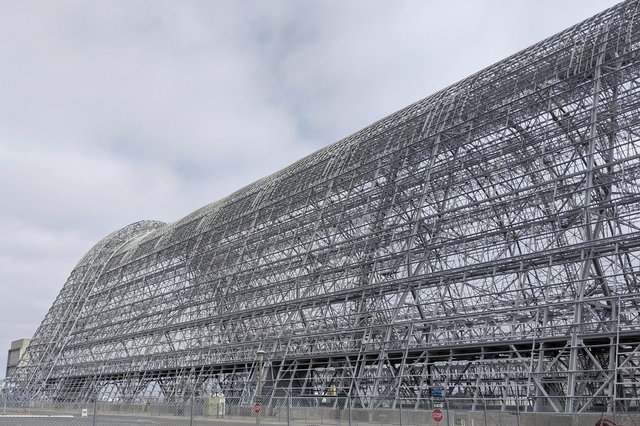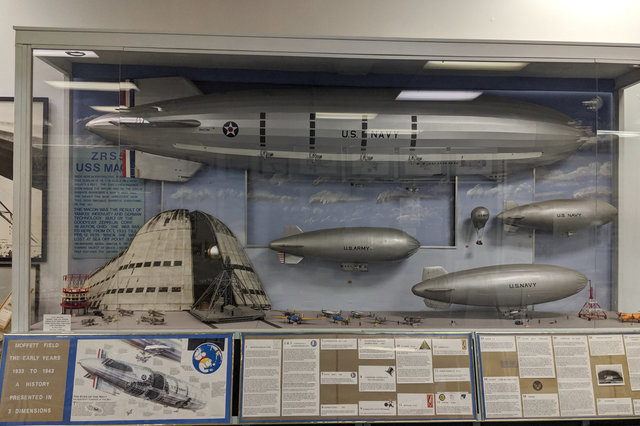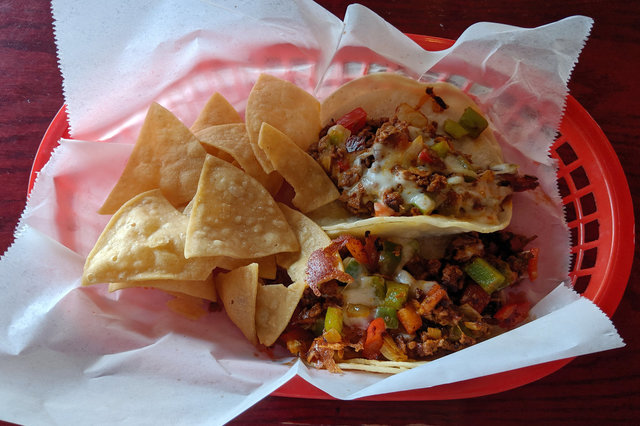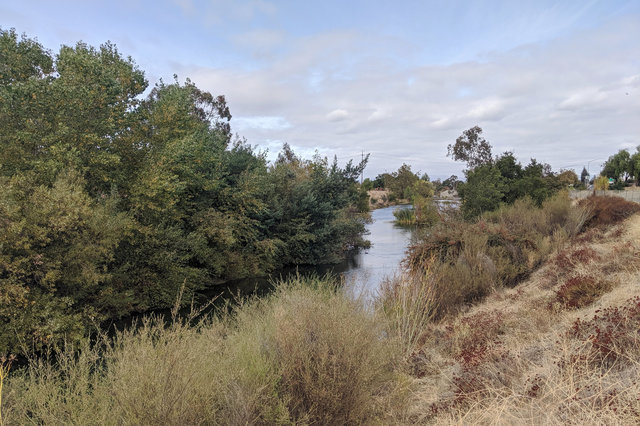South Bay
Started: 2019-11-29 15:24:27
Submitted: 2019-12-01 00:36:14
Visibility: World-readable
In which the intrepid narrator visits Moffett Field and visits a random suburb of San Jose
I visited my employer's offices in Mountain View in October to talk to my dev teams, and I stuck around the Bay Area on Saturday before heading back to Seattle.
My first stop on Saturday was the cozy Moffett Field Historical Society Museum. To get there I had to go through the main gate at the airfield, left over from the field's history as a naval air station. The guard looked at my id and asked where I was going and waved me through when I said I was going to the museum.
The route to the museum took me along Akron Ave at the center of the airfield, which seemed like it might have been the main parade ground in the field's days as a naval air station. While driving down the boulevard I was hit with a sudden memory from a visit to a Moffett Field open house sometime in the 1980s with my father; I remember walking down the main boulevard, with hangar number one looming in the background, to see and walk through the planes on display. At the time I wished that the planes would be suddenly called into emergency service while we were on board, without enough time for us to disembark, so that we would have no choice but to ride the planes in flight. (I also recall discussing cork, presumably because one or more of the trees on the boulevard had cork-like barks.)
The cozy Moffett Field Historical Society Museum occupied a one-story building on next to hangar number one. It held a bunch of apparently-random artifacts from the field's history as a Naval Air Station, presented with individual details but without much context as to how they fit into the overall history of the field. There were a bunch of Navy uniforms, mostly from the Second World War, most of them donated by the people who wore them.
One of the rooms showed a large model of the USS Macon, one of the rigid airships that operated out of Moffett Field in the 1930s that experimented with carrying its own air wing, making it a carrier airship. (The massive hangars were built to hold the airships; the hangars survive to this day, but the rigid airships proved to not be practical and were never built in numbers.) The Macon was lost at sea off the California coast in 1935, signaling the end of the rigid airship era.
A museum guide took visitors to the plane pen between the parking lot and the hangar, and I joined to get a closer look at the random assortment of aircraft parked there. The aircraft parked there included a retired NASA U2, a retired F18, an attack helicopter, and a restored Second World War warbird. There didn't seem to be a strong collection development policy around the aircraft on display, probably because the museum would take anything it could get because it didn't have enough aircraft to be choosy about them.
I went back inside the museum to wander through the rest of the galleries, including a fascinating cut-away model of a rotary piston engine (with an electric motor attached so it could spin and show how all of the parts worked), and a fragment of an incendiary bomb dropped on Oregon during the Second World War — one of the very few direct attacks on the US mainland during the war.
I found the museum's collection fascinating, but with all of the artifacts packed together it was hard to follow how they all fit together. I enjoyed my visit to the museum, but I feel like it would have been a fantastic museum to visit with a knowledgeable guide. (Or I could have asked any of the museum staff and volunteers wandering around; but I didn't have any specific questions to ask, just vague request along the lines of "tell me how this all fits together and what makes it interesting".)
I departed the museum and drove to Campbell, one of the numerous small cities in the sprawling Bay Area. The city is nestled between San Jose and Los Gatos and Cupertino. My vaguely-defined mission was to visit the city, as a proxy for the sprawling suburbs in the Peninsula and South Bay, to see whether I'd want to live there in the event that a suitable library job opens up in the area. (I have no doubt that I could find suitable employment in tech somewhere in Silicon Valley.)
When I arrived in Campbell I discovered that the city's tiny downtown (several whole blocks long) had been taken over by the city's Octoberfest, making it significantly more difficult than I expected to find parking and visit the downtown taqueria I had selected. (My choice was based mostly on seeing soyrizo on their menu.) I did eventually park and threaded my way through the people celebrating Octoberfest (including a polka band) to the taqueria, where the soyrizo tacos were in fact delicious, especially when augmented with the salsa from the sizable salsa bar.
I picked my way through the Octoberfest celebration crowding the streets and walked up Los Gatos Creek to Los Gatos Creek County Park, where I found several large ponds in the creek's floodplain with interpretive signs telling me they were percolation ponds intended to inject water back into the aquifer.
My overall impression of this corner of the suburban Bay Area matched my observation on the plane flying over the Peninsula on the approach to SFO a few days earlier: it was endless soul-crushing suburban sprawl; but it was my endless soul-crushing suburban sprawl, in a hard-to-articulate way that I felt like I understood it. It did not precisely feel like home, but it was home-adjacent, and maybe that's good enough.
With my brief visit to Campbell complete, I drove back to SFO, following 280 through the rolling foothills covered in dry "golden" grass, over SLAC and past the brightly-colored concrete house now featuring dinosaurs in its yard, and the kitschy statue of Saint Junipero Serra counting cars on the freeway; and flew back to Seattle.










